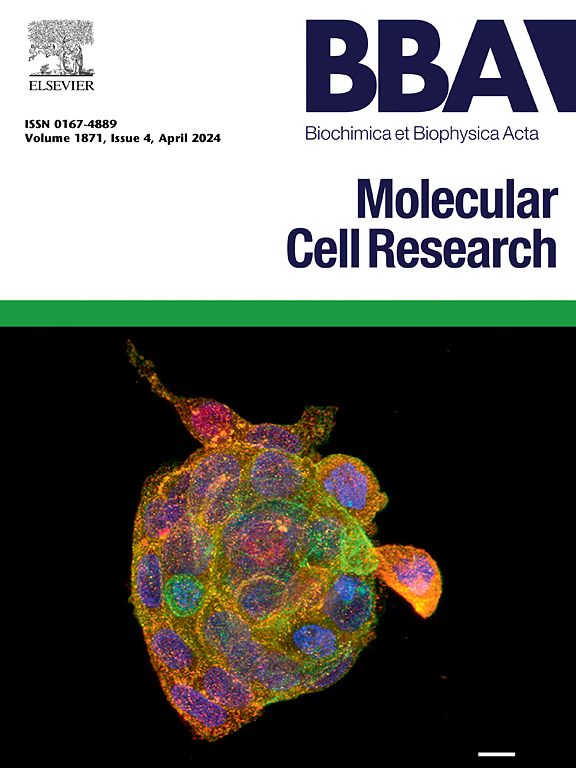Senolytic elimination of senescent cells improved periodontal ligament stem cell-based bone regeneration partially through inhibiting YAP
IF 3.7
2区 生物学
Q1 BIOCHEMISTRY & MOLECULAR BIOLOGY
Biochimica et biophysica acta. Molecular cell research
Pub Date : 2025-02-17
DOI:10.1016/j.bbamcr.2025.119921
引用次数: 0
Abstract
Periodontal ligament stem cell (PDLSC)-based tissue engineering is an important method to promote periodontal tissue regeneration. However, PDLSCs are susceptible to the effects of replicative senescence, leading to reduced proliferation and differentiation abilities and weakened tissue regeneration potential. Senolytics (the combination of dasatinib and quercetin) are drugs that inhibit cellular aging through inducing the apoptosis of senescent cells, but whether they have positive effects during the senescence of PDLSCs is unknown. The present study established a long-term in vitro culture model of PDLSCs and then analyzed the effects of senolytics on the senescence, apoptosis, and osteogenic differentiation of PDLSCs in vitro and PDLSC-based tissue regeneration in vivo. The results showed that senolytics delayed the process of aging in prolonged-cultured PDLSCs and promoted the elimination and apoptosis of senescent cells. Moreover, senolytics improved the osteogenic differentiation ability of both young and senescent PDLSCs in vitro and promoted PDLSC-based alveolar bone regeneration in vivo. Furthermore, senolytics inhibited the expression of YAP in senescent PDLSCs. Their antiaging effects were enhanced when combined with the YAP inhibitor verteporfin, but were inhibited when combined with the YAP activator NIBR-LTSi. Taken together, these findings suggest that senolytics promoted the elimination of senescent PDLSCs and enhanced senescent PDLSC-based bone regeneration, partially through the inhibition of YAP expression.
衰老细胞的溶解性消除部分通过抑制YAP促进牙周韧带干细胞骨再生
基于牙周韧带干细胞(PDLSC)的组织工程是促进牙周组织再生的重要方法。然而,PDLSCs易受复制性衰老的影响,导致其增殖和分化能力降低,组织再生潜力减弱。Senolytics(达沙替尼和槲皮素的组合)是通过诱导衰老细胞凋亡来抑制细胞衰老的药物,但它们在PDLSCs衰老过程中是否有积极作用尚不清楚。本研究建立PDLSCs体外长期培养模型,分析溶老剂对PDLSCs体外衰老、凋亡、成骨分化及体内基于PDLSCs的组织再生的影响。结果表明,抗衰老剂可延缓长时间培养PDLSCs的衰老过程,促进衰老细胞的消除和凋亡。此外,在体外,衰老剂提高了年轻和衰老PDLSCs的成骨分化能力,并促进了体内基于pdlsc的牙槽骨再生。此外,衰老剂抑制衰老PDLSCs中YAP的表达。与YAP抑制剂维替波芬联合使用时,其抗衰老作用增强,与YAP激活剂NIBR-LTSi联合使用时,其抗衰老作用被抑制。综上所述,这些发现表明,抗衰老药物促进了衰老PDLSCs的消除,并增强了基于衰老pdlsc的骨再生,部分原因是通过抑制YAP的表达。
本文章由计算机程序翻译,如有差异,请以英文原文为准。
求助全文
约1分钟内获得全文
求助全文
来源期刊
CiteScore
10.00
自引率
2.00%
发文量
151
审稿时长
44 days
期刊介绍:
BBA Molecular Cell Research focuses on understanding the mechanisms of cellular processes at the molecular level. These include aspects of cellular signaling, signal transduction, cell cycle, apoptosis, intracellular trafficking, secretory and endocytic pathways, biogenesis of cell organelles, cytoskeletal structures, cellular interactions, cell/tissue differentiation and cellular enzymology. Also included are studies at the interface between Cell Biology and Biophysics which apply for example novel imaging methods for characterizing cellular processes.

 求助内容:
求助内容: 应助结果提醒方式:
应助结果提醒方式:


